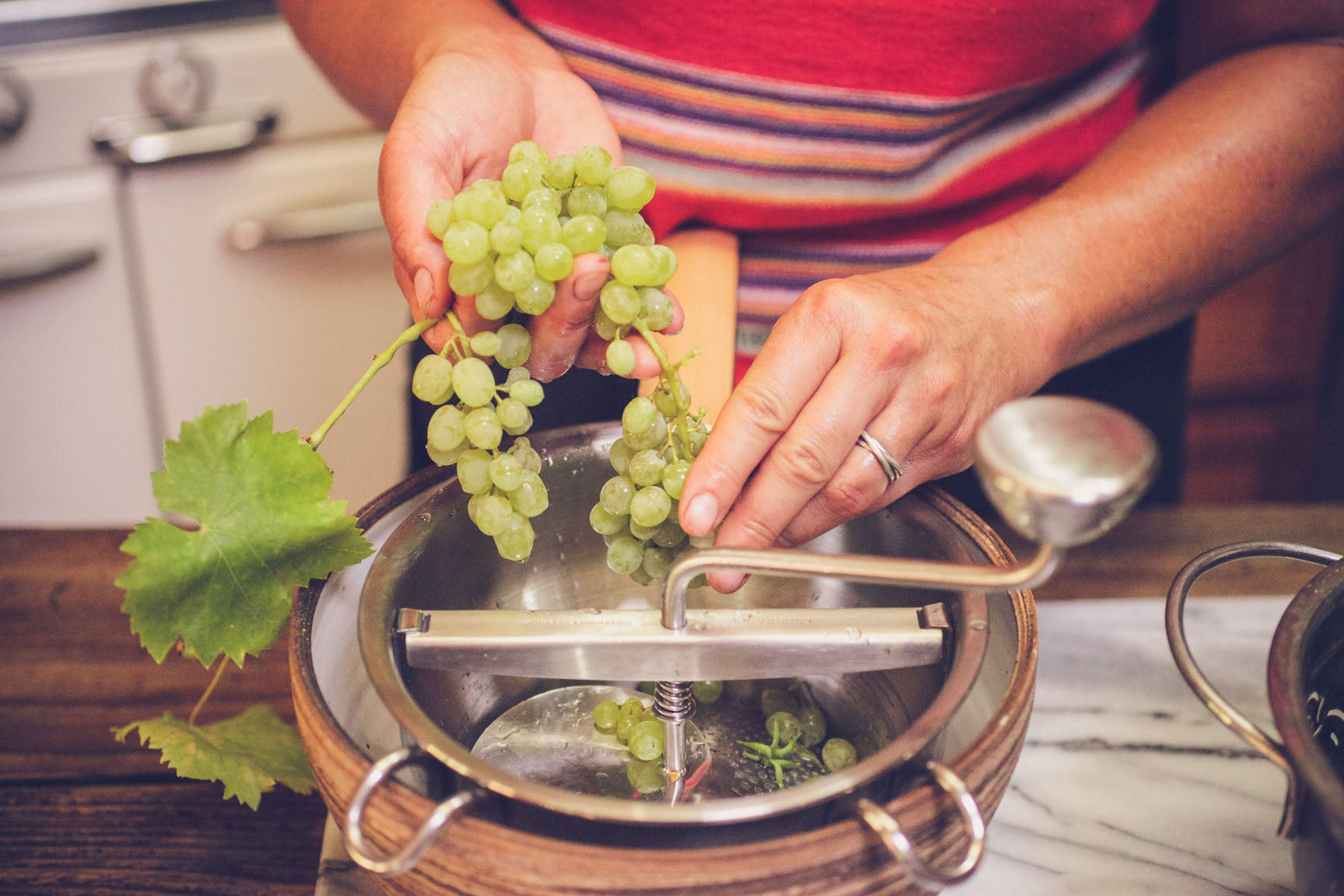- Continue Shopping
- Your Cart is Empty
Verjus

What You'll Need
Equipment
- colander
- food mill
- fine mesh strainer
- jelly strainer bags or butter muslin
- coffee filter or paper towels (optional)
- bottles or jars for storage
Ingredients
- 2 pounds unripe grapes
Verjus can also be spelled as verjuice, but it just doesn’t seem as fancy that way. And we like a bit of fancy, now and then. Verjus fits the bill, despite its somewhat muddy color. It’s a kind of forgotten cooking acid, that used to be far more common, especially in wine-producing areas. Because it is made with green, unripe grapes, verjus was traditionally made from the grapes that were thinned from wine-grape vines, in order to allow the remaining clusters to develop more sweetness. As with wine, the flavor of verjus can vary tremendously from variety and region, reflecting terroir.
Verjus has an acidity all its own, milder than lemon juice or vinegar, but still tart and sour, with just a whisper of sweetness from the sugar that has just begun to develop in the unripe grapes. It’s wonderful as part of a simple dressing over butter lettuce, or arugula based salads, and it is also fantastic when used to marinate or baste roast meats. particularly pork and chicken. But don’t stop there! It can be used as a replacement for lemon juice or vinegar in everything from mayonnaise to chutneys or drizzled over seasonal fruit for a simple dessert. Because it is made from grapes, but not as acidic as vinegar, the flavors of verjus are often prized for their ability to pair with wines and food; the verjus does not sour the palate for wine-tasting, as vinegar might. And speaking of tasty beverages, verjus is a magical cocktail and mocktail ingredient, as well. Try a splash in sparkling water or champagne.
To make verjus, choose unripe grapes, still a few weeks away from ripeness, that are just beginning to swell toward ripeness. With red grapes, it’s easier to see just when the right time is, because the grapes will just have begun to get their first blush of color. Even green grapes undergo a color change, though; they become more translucent, slightly more golden, less densely solid and more soft. Very young grapes will have too little juice to make them worth pressing, and grapes too close to ripeness will not be sour enough to be a proper verjus. Make as much or as little as you want; about 2 pounds of grapes will make a pint of verjus.
Directions
Select your grapes.
Rinse the grapes well and set them in a colander to drain. Remove the stems from the grapes; this will make it easier to run them through the food mill. Set a medium or coarse plate in the food mill. Working in batches, add handfuls of grapes to the food mill, and grind them through. Set a bowl beneath the food mill to catch the juice.
Set a medium or coarse plate in the food mill. Working in batches, add handfuls of grapes to the food mill, and grind them through. Set a bowl beneath the food mill to catch the juice.
 Pour the juice through a fine strainer to remove the larger sediment.
Pour the juice through a fine strainer to remove the larger sediment. Pour the juice through a jelly bag to remove fine sediment. Depending on what you want to use the verjus for, you may want to filter it through a coffee filter or paper towel as well, to remove more sediment. However, this is very time consuming and is mostly an aesthetic rather than a functional concern.
Pour the juice through a jelly bag to remove fine sediment. Depending on what you want to use the verjus for, you may want to filter it through a coffee filter or paper towel as well, to remove more sediment. However, this is very time consuming and is mostly an aesthetic rather than a functional concern. Allow the verjus to settle for a few hours. No matter how finely you strain it, there will likely be some sediment left on the bottom of the container after it has had time to settle. If desired, you can carefully pour the clearer juice off of the sediment on the bottom. You’ll lose some verjuice, but it’ll be prettier this way.
Allow the verjus to settle for a few hours. No matter how finely you strain it, there will likely be some sediment left on the bottom of the container after it has had time to settle. If desired, you can carefully pour the clearer juice off of the sediment on the bottom. You’ll lose some verjuice, but it’ll be prettier this way.
Store in the fridge for up to 3 months.
Over to You
It’s part of our mission here at Mountain Feed to help you make delicious, sustainable, homemade food more often. Stop by and say hello on Facebook, Twitter, Instagram or Pinterest. Or, as always, you can do it the old-fashioned way and come by the store to speak with one of our in-house experts.
